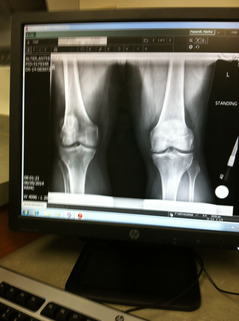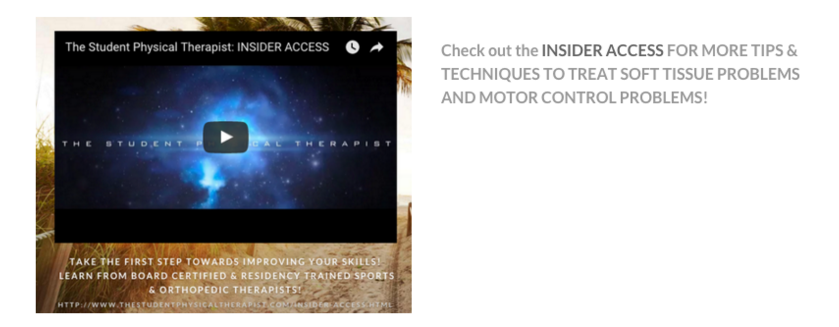- Home
- About Us
- TSPT Academy
- Online Courses
-
Resources
- Newsletter
- Business Minded Sports Physio Podcast
- Day in the Life of a Sports PT
- Residency Corner
-
Special Tests
>
-
Cervical Spine
>
- Alar Ligament Test
- Bakody's Sign
- Cervical Distraction Test
- Cervical Rotation Lateral Flexion Test
- Craniocervical Flexion Test (CCFT)
- Deep Neck Flexor Endurance Test
- Posterior-Anterior Segmental Mobility
- Segmental Mobility
- Sharp-Purser Test
- Spurling's Maneuver
- Transverse Ligament Test
- ULNT - Median
- ULNT - Radial
- ULNT - Ulnar
- Vertebral Artery Test
- Thoracic Spine >
-
Lumbar Spine/Sacroiliac Joint
>
- Active Sit-Up Test
- Alternate Gillet Test
- Crossed Straight Leg Raise Test
- Extensor Endurance Test
- FABER Test
- Fortin's Sign
- Gaenslen Test
- Gillet Test
- Gower's Sign
- Lumbar Quadrant Test
- POSH Test
- Posteroanterior Mobility
- Prone Knee Bend Test
- Prone Instability Test
- Resisted Abduction Test
- Sacral Clearing Test
- Seated Forward Flexion Test
- SIJ Compression/Distraction Test
- Slump Test
- Sphinx Test
- Spine Rotators & Multifidus Test
- Squish Test
- Standing Forward Flexion Test
- Straight Leg Raise Test
- Supine to Long Sit Test
-
Shoulder
>
- Active Compression Test
- Anterior Apprehension
- Biceps Load Test II
- Drop Arm Sign
- External Rotation Lag Sign
- Hawkins-Kennedy Impingement Sign
- Horizontal Adduction Test
- Internal Rotation Lag Sign
- Jobe Test
- Ludington's Test
- Neer Test
- Painful Arc Sign
- Pronated Load Test
- Resisted Supination External Rotation Test
- Speed's Test
- Posterior Apprehension
- Sulcus Sign
- Thoracic Outlet Tests >
- Yergason's Test
- Elbow >
- Wrist/Hand >
- Hip >
- Knee >
- Foot/Ankle >
-
Cervical Spine
>
- I want Financial Freedom
- I want Professional Growth
- I want Clinical Mastery
|
As you may have heard, recently physical therapists in Wisconsin have been allowed to order x-rays. One of the rights that separates chiros and MD's from physical therapists is the ability to order imaging. A significant component of our doctoral education is built upon understanding imaging, so the APTA and subsidies in each state have been working on getting physical therapists the right to order x-rays. While this is a significant step forward in public perception and autonomy as a profession, I have some very strong concerns. If you pay attention to much of the pain science research, you likely are aware of the large number of studies that reveal the lack of correlation between imaging findings and pain. If you take 1000 health people (without pain) off the street and take an x-ray of their lumbar spines, anywhere between 30-70% of them would have spinal stenosis, osteophytes, herniated discs, etc. Simply put we cannot link pathoanatomical findings with pain. So what does this have to do with our ability to order x-rays? Well, one of the things that sets us as physical therapists apart from other health care practitioners is the fact that we base our diagnoses off impairments, not tissue health (or at least that's how it should be). We find weak glutes, we try and strengthen them. We find a stiff lumbar spine, we try and mobilize/manipulate it. The point is the impairments guide our treatment, not the x-ray findings. What I am concerned about, is that with the ability to order x-rays, PT's will suddenly start ordering x-rays on every other patient. Low back pain? X-rays. Knee pain? X-rays. It is inevitable that degenerative conditions will be found on the imaging and likely will be blamed for the patient's pain. In my opinion, this is next to medical malpractice. Some of the most difficult patients to treat are the ones that have their imaging findings memorized and are afraid of "crunching down on a nerve." We must be careful so as not to create these thought viruses in our patients. Now, I absolutely still support physical therapists gaining the right to order x-rays. With our training in being able to screen patients for fractures, infection, cancer, and more, I think it can help to streamline the health care process and save money for our patients. But we must avoid ordering x-rays for every musculoskeletal injury that walks in the door. Remember, the imaging should not guide our treatment, unless managing the condition is outside our scope of practice i.e. a fracture, infection, etc. Congratulations Wisconsin PT's! Show the rest of the country that we won't abuse the power of ordering x-rays and potentially harming our patients! -Chris
10 Comments
5/17/2016 01:38:23 am
Any referral for Xray Scan etc should be based on clinical reasoning and not on pain and I think the more experienced PT will do just that. Perhaps this privilege should be only be afforded to the more experienced PT
Reply
Matome
5/18/2016 06:36:52 pm
Hi Chris!
Reply
Hello Matome,
Reply
Reginald Cociffi-Pointdujour
3/17/2020 08:41:23 pm
I'm not sure why this is the concern. What has anyone suggested to you that would make you believe that PTs would just order X-Rays for anybody or for most people they see. I'm not sure where the concern comes from.
PT student
5/25/2017 06:41:27 am
Chris
Reply
Hello PT Student,
Reply
Dan
9/28/2017 06:19:50 pm
This is ridiculous. Not a PT not a PT student but come on. PT is the one professional besides an orthopedic surgeon or a sports med doc that would actually have a top tier understanding of biomechanics to know when ordering an x ray or imaging is appropriate. Maybe you’ve never been to a doctor before, but you should worry more every doctor from a family med internal med, PA, NP ordering superfluous imaging for orthopedic/musculoskeletal issues before a DPT who can actually properly correlate clinically what’s wrong with a patient and decide if imaging is necessary. If you truly are a student PT you have little understanding of your own profession and that of the medical community treating musculoskeletal issues.
Reply
jesse
9/28/2018 08:19:37 pm
when subjective & objective fit myositis ossification I have to do the following. Send the athlete to PCP, who then sends him to ortho, who then sends him to radiology to get film, who then sends him back to ortho to get film read. Or i could send this kid directly to imaging. all the while using my other PT as usual. Imaging is just another tool that we wont overuse because were well educated.
Reply
Amy Bennett
1/18/2019 10:12:45 am
Hi, Chris -
Reply
PT
2/28/2020 07:24:44 am
Please read his last paragraph.
Reply
Leave a Reply. |
Dr. Brian Schwabe's NEW Book in partner with PaleoHacks!
Learn residency-level content on our
Insider Access pages We value quality PT education & CEU's. Click the MedBridge logo below for TSPT savings!Archives
July 2019
Categories
All
|









 RSS Feed
RSS Feed